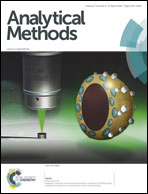Detection of di(2-ethylhexyl)phthalate through graphene–β-cyclodextrin composites by electrochemical impedance spectroscopy
Abstract
A β-cyclodextrin–graphene (β-CD–G) hybrid composite modified glassy carbon electrode for the first time was used for electrochemically detecting di(2-ethylhexyl)phthalate (DEHP), based on the inclusion of DEHP into β-CD. The electrode was characterized by cyclic voltammetry and electrochemical impedance spectroscopy. At the composites electrode, the impedance value increased linearly with the increasing DEHP concentration in the range of 2 μM to 18 μM, the limit of detection was 0.12 μM (3σ method), with a correlation coefficient of 0.998. The electrode showed good selectivity, reproducibility and stability. Obviously, the collected amounts of DEHP by β-CD–G could be detected through this electrochemical method. Furthermore, this simple and low-cost sensing platform can in principle be extended to the detection of other phthalate esters which can form host–guest complexes with cyclodextrin.


 Please wait while we load your content...
Please wait while we load your content...